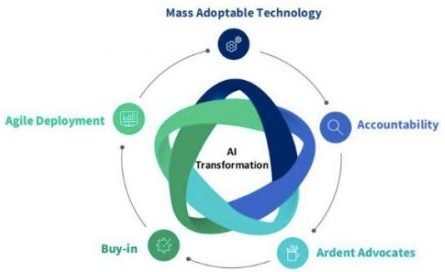Mass-adoptable technology for AI-enabled Operational Excellence
Digitization of the manufacturing sector has the potential to boost heavy-industry profit margins by three to five points provided people can make the new technologies work at scale. Unfortunately for industrial businesses, scaling AI initiatives has been challenging. Several experts have talked about AI transformation at large enterprises and the focus has been on vision, strategy, people and culture. Those are important but don’t provide a comprehensive approach and overlook multidimensional factors that are necessary to succeed at digital transformation.
After years of working with some of the biggest names in Metals, Oil & Gas, and the Semiconductor sector, accelerating AI transformation and advancing operational excellence, we have learned that transformations don’t happen from the inside out – they grow on you from the outside in.
Based on our extensive experience thus far, here are four simple rules to guide your transformation – whether you are a large company trying to transform, a small startup wanting to be an agent of change, or a services firm hoping to bridge the gap between these two.

Rule 1: Transformations are catalyzed by mass-adoptable technology.
If it were not for mass-adoptable technology, there would be no transformation. There is no dearth of reference points – language, wheel, printing press, democracy, steam engines, telephone, electricity, peaceful non-cooperation, transistors, calculators, Internet and smartphones are how we think of human development. Most industrial companies already have executives who are very good at execution and have a strong technical understanding of their problems. While they may be quite prescient about these factors, those who don’t have operating experience could easily make mistakes about which technologies are good for scaling AI-enabled Operational Excellence. Mass-adoptable AI technology doesn’t imply simple core tech, but tech where complexity has been tamed into a simple artifact from an end-user perspective. Such technology should have the absolute minimum prerequisites such as no data scientists required, no labels required, and no historical data required.
Rule 2: Transformations require ardent advocates, who will put their reputations on the line.
Transformations require ardent advocates for predictive operations and they are rarely insiders. This is what (social, economic) entrepreneurs, who will risk everything they have, do. Consider Marc Benioff. In 1999, he founded Salesforce with the dream to convert software into a service. For 20 years, he continued to lead the charge from the front and in the process he busted many myths and established SaaS as a meta-category. All the reasons that are often cited as causes of failures in enterprise transformation are basic challenges in human behavior and transformations that matter, succeed despite them.
Rule 3: Buy-in should occur spontaneously at the broadest level possible.
Consider that non-violent social transformation happened not just because of Mahatma Gandhi but because of the anonymous marchers who joined him. They had to understand and buy in because they saw the pain firsthand and believed in the non-violent methods to address that pain. The mass-adoptable tool of non-violent civil disobedience was a competency growth at the broadest level possible – something like 300 million Indians learned it over 25 years – 1920 to 1945.
Spontaneous buy-in in enterprises arises when every stakeholder sees the transformation to AI-enabled Operational Excellence as advancing their own professional interests. That is, when they are the new owners of the transformation and when the results are genuinely insightful and valuable.
Rule 4: Actors must produce outcomes at marginal costs.
Accountability cannot be spared in organizations whose entire reason for existence is their discipline. Transformations can only happen when there is enough inefficiency that there is an incentive for bold action. Good technologies are able to scale down the investment needed and create zero marginal cost of value creation. Being brutally honest about value creation is essential for ending up on the right side of transformation – it is just like developing good habits at an early age. Many large companies are trying to do this and it makes the digital transformation teams uncomfortable. It is important to demand the most return upfront, even within the first 90 days.
Commit to two years for targeted results with one or more opt-out events.
AI grows exponentially more valuable over time but that time doesn’t have to be forever. Two years will suffice. Now, all sides suffer if strategic planning cycles are shorter than that. It is necessary that both sides are held accountable and that requires exit options at meaningful intervals. I posit that the right exit moments are 90 days and 1 year from start.
In the end, scaled AI-enabled Operational Excellence is so hard to attain that both sides of the story have to hold the other side brutally honest. We are doing that with our customers and have become the “little engine that could” in the process.
P. S. Most conventional approaches for adopting AI in industrial companies sound very much like Viant, Scient, and Accenture from the early days of the WWW, whereas what really won, in the end, was a mass-adoptable Website design tool such as Macromedia Dreamweaver. It didn’t do everything that the client wanted but it did make their project costs far more reasonable because it didn’t require hiring a new crew who knew HTML. Everyone and their son started doing this until we reached a point that grandmother too needed a site and, then, new tools like Squarespace and Wix were born. We need a DreamWeaver for AI-enabled Operational Excellence and I think the Falkonry Time Series AI Platform is the answer.


